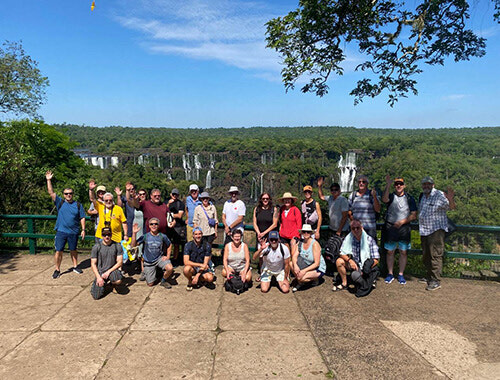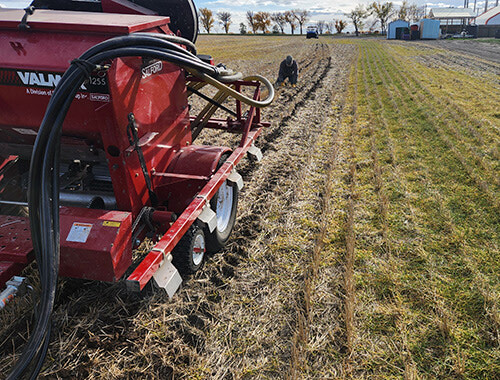Article by Natalie Noble for the Fall 2024 Farming Smarter Magazine
Originally titled: Farmers now pay to grow - Government withdrawal from extension threatens Alberta's world-class potential
In the late 1800s, American agriculturist Seaman A. Knapp began visiting farms with expert-led demonstrations held right in the field.
“His belief was, if farmers applied new technology themselves, observed it and it worked, they would be more likely to adopt it,” said John Knapp, former Alberta Agriculture deputy minister (no relation to Seaman). “He's widely regarded as the Father of Extension in North America.”
Filling the gap between ground-level research needs, researchers and those who invest in it, extension in Alberta today is challenged, particularly in public investment. “It's a critical piece to everything we do that's overlooked. It's underappreciated,” said Farming Smarter executive director Ken Coles.
“Extension is about our connections to farms, sharing knowledge, having relationships with farmers and a two-way communication channel feeding into the entire innovation system. We’re siloed up. Government backed out, and honestly, they’re not providing leadership.”
While funding isn’t a new problem, it’s at a high point. “For decades, massive investment dollars have gone into research, such as improving production or pest management,” said Rick Taillieu, director of engagement and analytics at Alberta Canola. “The challenge lies in getting the results out to farmers. It’s a problem that’s been around as long as agriculture.”
Flash forward from the 1800s to 1977, when Knapp served as a rookie district agriculturist. There were 100 district agriculturists across Alberta, 63 home economists, and a network of specialists in six regional offices from Fairview down to Lethbridge. Across 60,000 farm families, approximately 600,000 contacts were made between Alberta Agriculture’s district offices and rural clients – an average 10 contacts per year, per farm family.
“You can see contact with the district's office was deep and profound,” said Knapp. “Clearly, they were a vital and useful part of advancing agriculture, helping [farm families] make more profitable decisions, achieve better quality and environmental outcomes.”
With extension agents and specialists integrating producer concerns into a comprehensive set of recommendations, the system ticked along until the mid-’90s. The province downsized 20 per cent to a team of in-field specialists. Over time, a series of budget cuts dwindled public investment.
By 2020, the Alberta Government essentially exited from extension investment. “We don't have our own system of specialists anymore. That's something we need to put back in place,” said Knapp.
|
|
|
Research plots growing information farmers and agronomists need. |
Todd Green, Newell County director of agricultural services, described the outcome. “We still have 310-FARM, but we don't have the same level of expertise on the other side of that phone call,” he said. “We used to work with people on things more directly relevant locally. Now, it's often bigger questions, broader topics and things I need to do more research on.”
Russel Muenchrath, former Wheatland County manager of agriculture and environment, said the challenge in connecting producers with research has grown alongside funding issues since his day in the district agriculturist model with district and provincial specialists. “That local level of expertise was more accessible. Producers could stop into the office,” he said. “It was easier for specialists to go out and do farm calls. Farmers can search on their smartphone now, but it's not the same as the local ground level support we had.”
Government withdrawal from publicly funded extension forced most specialists into the contract market. “It became a fee-for-service model,” said Muenchrath.
That transformation costs farmers. “In the absence of public money, the producer ends up paying for extension through check off dollars, association memberships, or event fees that require cost recovery,” said Taillieu. “Where farmers, through producer organizations, previously identified research needs and resulting extension, the federal and provincial governments matched funds to those needs. Now, priorities have changed at both levels, that alignment is missing and growers are on the line, directly or indirectly, to pay for the research or events they want.”
The new model means projects launch under trial and error - a costly path forward. While excitement and criticism around the Ag Extension Alberta Working Group varied – a collaborative endeavor representing numerous sectors from poultry to grains – its recent halt exposed cracks in the current system.
From the outside looking in, Coles saw problems early. “There must be genuine dialogue from the onset, not, ‘let's make a plan, check some boxes and then find out it’s not going to work.’”
"You can see contact with the district's office was deep and profound. They were a vital and useful part of helping [farm families] make more profitable decisions. Average 10 contacts, per year, per farm family."- John Knapp |
Noting that he and other proven extension players were not invited to the committee, Coles said rather than creating a new organization stacked with governance, power positions and roles, the money left on the table could better serve Albertans through already performing extension groups. “I'm frustrated, when we're all stretched thin, how much money is wasted hiring companies to tell us what we already know,” he said. “If they had taken all that money and invested it in extension, and those of us already doing it, we would be much further ahead.”
In its second round of committee work, the Working Group planned a pilot project. “But you can't run a pilot project on a program that depends on people,” said Coles. “They needed a human-centric, specialist approach with a budget around $20 million per year. Creating a short-term contract in a new organization is bound to fail. On top of that, it would be nearly impossible to find any specialists without cannibalizing other organizations.”
That suspension is a disappointment for those who hoped it would shoulder some burden the government’s retreat placed on them. “I thought it was a unique approach and I was excited to see how it went,” said Green. “I don't know that it got a fair shake. It was basically in its infancy and got shut down. That’s unfortunate. It included some of the last, not paid-for-service extension people, which is what we are. It would be nice to have extra help.”
Solution-wise, consistent, constant messaging helps, whether it’s getting innovation out to farmers or influencing politicians to prioritize agriculture. Unity is also echoed. “Our agricultural service boards, often made up of local farmers, have connections to our provincial government. They are picking up some slack as a unified voice within their jurisdictions towards the province and filling that void that was left from Alberta Agriculture,” said Muenchrath.
As agriculture is politically overshadowed by priorities like education and health care, its public good interest must be showcased. “We’ve been far too modest about social license,” said Knapp. “We need a group effort by everyone – the commodity associations, government, municipal agriculturists, other policy groups – to come together and talk about it.”
Knapp said Alberta has the fundamentals to lead agriculture on a global stage, except one. “There is a public good in having a capable group of producers and an agricultural system that meets international standards. It is flexible and nimble enough to move with changing market demands. It serves the social license in environmental and other issues. It supports our economy, helps build hospitals, roads and police forces.” he said. “The missing link is that extension specialist piece. What is regrettable is the complete removal of public funding and the need to consider whether there should be some public role in extension at some point.”




